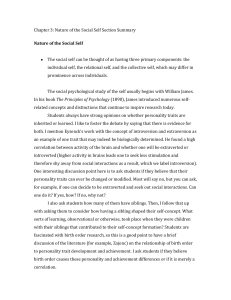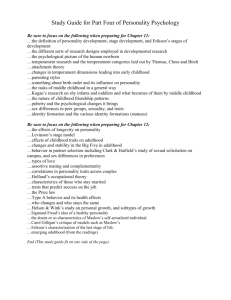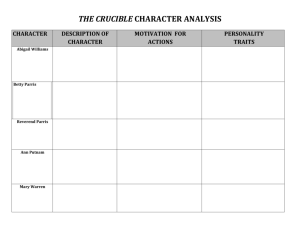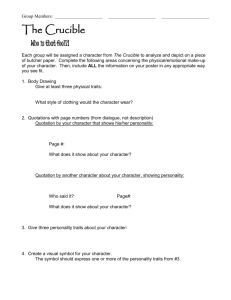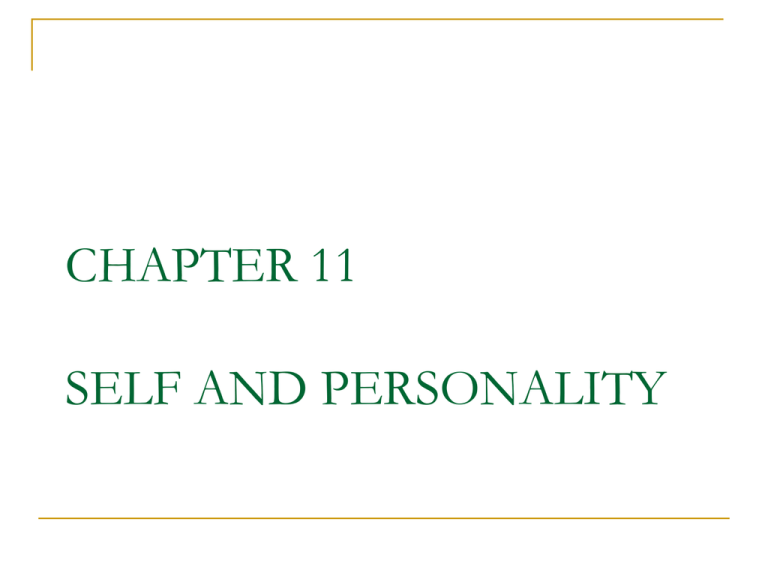
CHAPTER 11
SELF AND PERSONALITY
Personality
An organized combination of attributes,
motives, values, and behaviors
Patterns of traits
Unique to each individual
Consistent across situations and time
Self-Concept: Perceptions
Self Esteem: Evaluation
Identity: Overall sense of who you are
McAdams and Pals (2006) Five
Principles
Personality shaped by evolution for
adaptation to environment
People differ in dispositional traits
People differ in characteristic adaptations
Each has a unique life story
Cultural and situational influences ever
present
Psychoanalytic Theory:
Sigmund Freud
Three parts of the personality
Selfish Id; Rational Ego; Moralist Superego
Stages of psychosexual development
Biological: ends at sexual maturity
Personality formed in first 5 years
Childhood anxieties become adult traits
Psychoanalytic Theory: Erik
Erikson
Emphasized
Social influences
Rational ego
Life-span development
Crisis-Oriented Stages Result From:
Maturational forces
Social demands
Trait Theory
Psychometric Approach
Personality: a set of traits
Individual differences in each trait
Measurement approach
“Big Five” - Universal and stable
Evidence of genetic basis
Universal
Social Learning Theory
Personality: A set of behavior tendencies
Shaped by interactions
Found in specific social situations
No universal stages
Not enduring traits
People change as environment changes
Situational influences important
E.g., cheating
Infancy:The Emerging Self
First 6 months: Discover physical self
Joint attention at about 9 mo
Difference in perceptions can be shared
Self-recognition about 18 months
Categorical self (age, sex): 18 – 24 months
Based on cognitive development
Requires Social Experience
The looking-glass self: a “reflection”
Temperament
Seen in infancy
Genetically based
Tendencies to respond in predictable ways
Building blocks of personality
Goodness of Fit (Thomas & Chess)
Parenting techniques
Learning to interpret cues
Sensitive responding
Changes in Self-Concept: age 8
Include psychological, social qualities
Previously used only physical traits
Increased Use of:
Social comparison, multidimensionality
Hierarchy with self-worth on top
More accurate self evaluations
Widening gap between ideal-self and real-self
Contributions to Higher SelfEsteem
Competence!
Positive social feedback
Warm democratic parents
Social comparisons that are positive
Some temperament traits
established
Will develop into adult traits
The Adolescent
Increased awareness of psychological
and abstract traits
Self-concept more integrated
Self-esteem dips temporarily, rebounds
Erikson’s Stage of Identity vs. Role
Confusion
“Who Am I?”
Can last as long as into early 30s
Marcia’s Ego Identity Statuses
Diffusion: “Hey wait a minute – they didn’t know
everything. Maybe I’m not who they said I was.”
(No crisis. No commitment)
Foreclosure: “I’ll be a (Catholic, Democrat,
doctor, etc.) because that’s what they told me
was right.” (Commitment without crisis)
Moratorium: “Who am I? What is right? Who will
I become?” (Crisis, no commitment)
Identity Achieved: “I can make my own life
choices.” (Commitment, evolved from crisis)
•
The Four Identity Statuses as They Apply to Religious Identity
Identity Achievement
Ethnic Identity begins in infancy
Vocational Identity - increasingly realistic
“Goodness of fit” becomes useful
Influential Factors
Cognitive development
Openness to experience trait
Warm, democratic parenting
Culture that encourages exploration
Self-Concept and Adulthood
Stable Self-Esteem
Generally good
Ability to adjust ideal to real self
Evaluate self with different standards
Comparisons with age-mates
Related to stable personality traits
Losses in self-esteem in later old
age
Changes in Personality
Cross-sectional studies show more changes
Longitudinal, Cross-Cultural Studies
Adulthood: achievement and confidence
Older adults
Decrease: activity level, openness to
experience
Increase: introversion, emotional stability,
conscientiousness
Influences on Personality Change
Heredity
Earlier experiences
Stability of environment
Biological factors (e.g., disease)
Poor person-environment fit
Adulthood – Erikson and Research
Identity provides for intimacy in young
adulthood
More traditional women solve identity
crisis after intimacy (marriage, children)
Midlife generativity supported
“Midlife crisis” not supported
Integrity in old age supported
Includes life review
Life Stories: narrative identity approach
Vocational Development
Young adults: Career exploration
Thirties: Settling down
Forties & Fifties: Career peaks
Older Workers
Competent, satisfied, and positive
Selective optimization with
compensation
Retirement
Average age 63
Adjustment phases
Success Factors:
Person-environment fit
Selective optimization with
compensation
Disengagement versus Activity Theory
Support for activity theory



